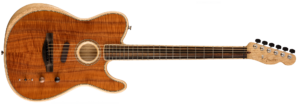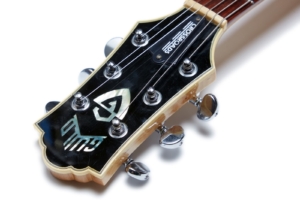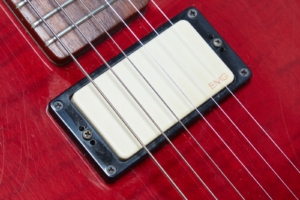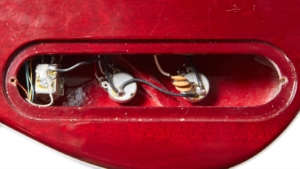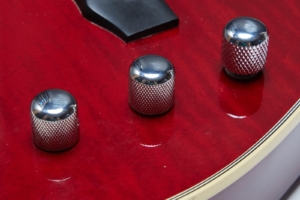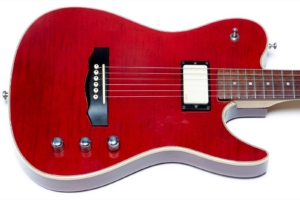
Introduction
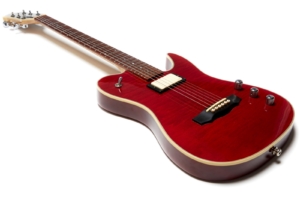
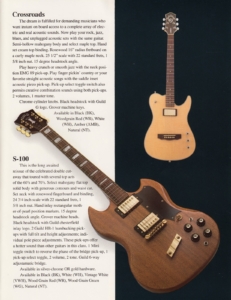
The neck is very much like an electric guitar – a Strat or a Tele to be specific, in that it has a 25 1/2″ scale length with an unbound rosewood fretboard with 22 frets. The neck is a bolt-on, but it’s not like a Strat or Tele because it has a relatively flat 16″ radius not to mention the fact that it has a 6×6 headstock.
Clearly, the guitar is shaped like a Telecaster, but it has a very acoustic-guitar type bridge with bridge pins to hold the strings. But it has an EMG pickup! But it also has a piezo pickup. And it’s hollow! Not only is it hollow, but it’s braced like an acoustic, though it has a flamed maple top.
This guitar kind of makes my head hurt.
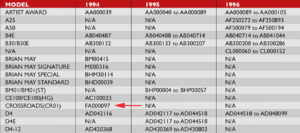
The often incorrect Guild serial number list indicates that only 97 of these guitars were made. Is that accurate? As with all production numbers only Hans Moust, author of The Guild Guitar Book knows for sure, but I’ve seen serial numbers as high as FA000091 out there, so that seems at least close to being true. Production serial numbers don’t always start at 1, though.
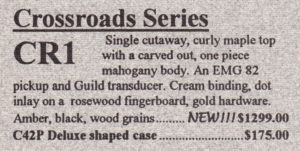
But wait, there was!
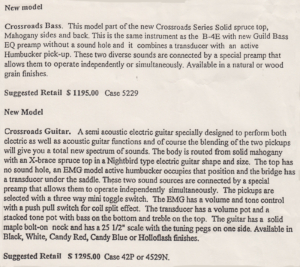
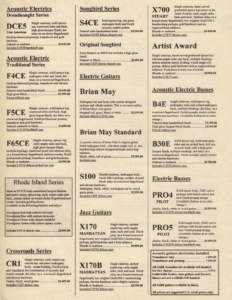
In the January 1995 price list we can see that the pickup has been changed to Guild pickup and the hardware is now listed as chrome. The price is up to $1499 but now includes the C42P case, that case being the same one listed for the Original Songbird on the same page. By July 1995 the guitar was no longer listed, which isn’t surprising given that only 97 of them are said to have been made.
I like to say that this guitar was a good 25 years ahead of its time. Why? Well, consider this, the Fender American Acoustasonic Telecaster:
Launched by Fender at the 2019 NAMM show, the Acoustasonic is designed to work as an acoustic, an electric, and everything in-between. Or something. The Koa model shown above has a list price of $3999, but to be fair it’s a limited edition model and the regular ones go for a somehow more palatable $1999, but I showed the Koa model because the regular ones are (in this humble reviewers opinion) profoundly ugly. I mean ugly on a scale that shouldn’t even be uttered in the same paragraph with the price tag. Let’s just say that the design and color choices have proven to be divisive in every online discussion I’ve seen about them.
Looks aside, the Fender Acoustasonics are a pretty cool idea wherein a guitar in the form factor of a thin electric performs like multiple guitars including an electric and an acoustic. Sound familiar? Now these are not identical instruments because the Acoustasonic has the ability to sound like a variety of acoustics through the use of five different digital voices, three different pickups, and the ability to blend them all to taste. It’s honestly a very interesting concept, even if it isn’t beautiful.
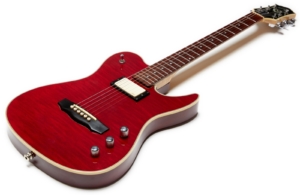
The Guild CR01 doesn’t have any digital manipulation going on. It’s really an electric guitar and it’s really an acoustic guitar and you can mix the two together. That’s actually true of the Acoustasonic as well, and I think the Acoustasonic beats the Guild in the fact that it has a bridge electric guitar pickup where the Guild CR01 has a neck electric guitar pickup. Clearly it’s also more versatile, but man do I ever think that the Guild looks better.
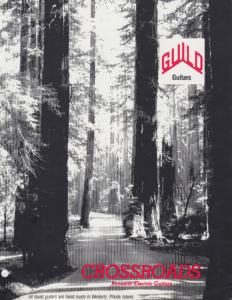
Guild was never great at naming things, and typical of Guild they had used the Crossroads name before. Back in 1984 or so they released the Crossroads catalog which contained all acoustic-electric guitars that have pretty much nothing to do with the design of the Crossroads CR01. All the guitars in that catalog are soundhole-equipped acoustic guitars that are devoid of EMG pickups, though they are all pretty non-traditional in the overall shape department. It makes me laugh when companies reuse names because it makes me think that the executives were convinced that no one would notice.
But wait; there’s more!
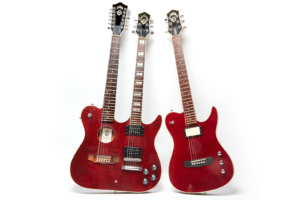
The case
The case for this guitar, at least according to the price guide, is the same case that Guild Songbirds came in, which is listed as the C42P Deluxe shaped case that was an additional $175. The fact that the case was not included in the original price may account for the fact that many of the Crossroads CR01s I see for sale do not include the original case. When I asked Hans Moust about this, he posited that with the then recent availability of actually useful and protective gig-bags, people simply opted for a more useful solution that likely came in at a lower price.
Finish
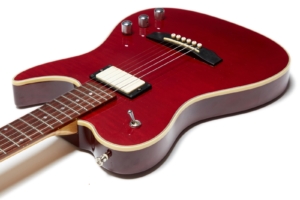
The quality of the finish is exemplary like it is on most every US Guild I’ve ever handled. The 1994 catalog lists the available finish colors as Black (BK), Woodgrain Red (WR), White (WH), Amber (AMB) and Natural (NT). The guitar in this review is Woodgrain Red if that wasn’t obvious by the photos.
Fretboard and Neck
The first thing that caught my eye about this guitar was the glorious headstock. With the G-shield logo and 5-layer binding, the contrast with the headstock veneer against the flamed maple really pops. As beautiful as the headstock is, and with the glorious flamed maple neck, I felt like the guitar looked a little odd with an unbound fretboard, though this seems to be a pretty common trend where Guild combined acoustic guitar sound with electric guitar playability. For example, the Crossroads doubleneck has no binding on the acoustic neck, and both the Songbird and the GX guitars in my possession, both of which are designed to play like an electric have the same no-binding design, though to be fair neither of those guitars have a bound headstock. It just looks odd to me to have a guitar where the headstock and body tops are completely bound only to be joined by an unbound neck.
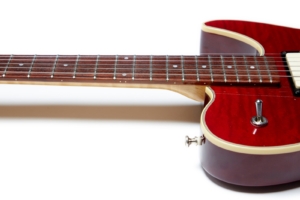
The catalog states that this model has a 1 5/8″ neck and a 15 degree headstock angle, but the neck on mine is quite clearly 1 11/16″ at the nut. The neck is what I would imagine many people describe as “just right” since it’s not painfully thin nor is it super-thick. It is, however, remarkably unchanged in its depth, measuring .80″ from the nut all the way up to the 7th fret and beyond, only fattening up a bit towards the neck heel. The inlays are simple dots.
The neck is a gloriously flamed maple with a mahogany strip down the center, and every CR01 I’ve seen has a similarly flamed maple neck. Unfortunately on mine, it appears as though someone over-tightened the truss-rod which caused the neck to crack right down that center seam.
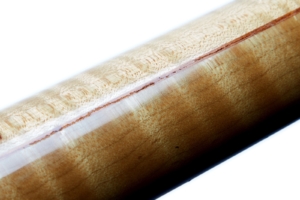
Build Quality
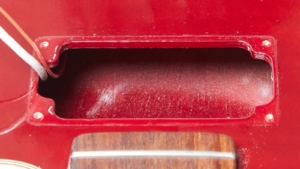
Like a Tele, the guitar has a bolt-on neck which is a fairly uncommon design on Guild electrics, though not totally unheard of. While a bolt-on neck makes for easy neck replacement, the neck on this guitar is not easily replaced if the desire is to keep the same Guild G-shield headstock design as seen above in the Fretboard and Neck section.
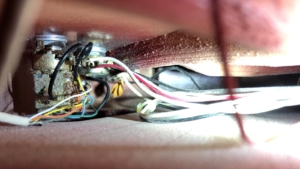
Naturally as I went to take a look inside my cheap Chinese bore scope broke. Again. That was my fourth one so I finally decided to stop wasting my money and bought a real American one designed for automotive and aviation use. ‘Murica!
As it turns out this borescope was also made in China, but the company I bought it from is in South Carolina, so… ‘Murica? By the way, this picture of the wires was taken by jamming my iPhone into the pickup route and it’s the best internal picture I took by far. Sigh. At any rate, this nicer borescope actually works and allows me to see around corners and do all sorts of neat stuff, none of which helped on this guitar because this guitar is completely hollow except for all the wires and the bracing.
As you can see in the above image the guitar is not only completely hollow, but it also has top braces just like an acoustic, though what pattern those braces are in involved me mapping out the top in a way that exceeded my attention span. The catalog says that it is X-braced, so there you go.
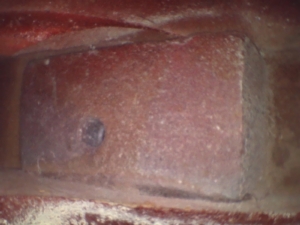
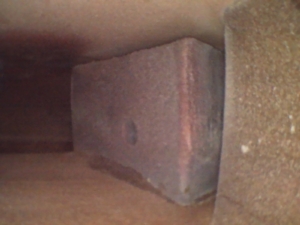
Anyway, it’s heavy because there’s blocks of freaking wood screwed into the body near the end pin. Cool, eh? My guess is that they’re counterweights since the light body would make the guitar neck heavy without them. Whatever the reason, if you’re going to hit someone with this rare and expensive guitar, try and make contact with the wide end for maximum effectiveness.
Pickups
The Neck pickup is an EMG 89 with a cool white cover. Well, I think it’s cool. A fair number of people seem to hate it, and since a fair number of people seem to hate EMGs to begin with, I get it. Hell, I used to dislike EMGs too, but they definitely have their place. As to whether that place is on an acoustic/electric guitar hybrid I’m not so sure, but since this guitar is so unique I think the white covered EMG works for me.
The EMG 89 is an interesting beast. It’s actually two Alnico-V based pickups with two separate preamps that are selectable with a push/pull pot, thus giving it the feel of a coil-split humbucker. Since it’s actually two pickups the wiring is a fair bit more complex, which I’ll cover in the Electronics section below. As of April 2020 this is a $125 pickup with the white cover being an additional $6 over the stock $119, and yes EMG still makes them!
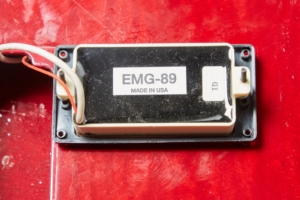
The EMG pickup ring has three holes on each side which is apparently legitimate because I’ve seen pictures of others with the same setup. In my (admittedly Internet-based) research I’ve seen the following combinations of pickup covers and rings on these guitars:
- White pickup, white ring (that ring may have been altered)
- White pickup, black ring like the one on my guitar
- Black pickup, black ring
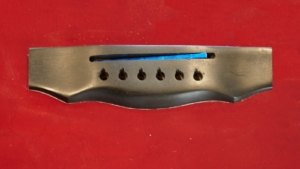
By the way, you may notice that the blue pickup is sticking up on one side. That is as a result of me trying to remove it which likely shouldn’t be done from the top. Thankfully it still works perfectly after being gently shoved back down into position by the saddle upon reassembly.
Electronics
There are no less than three panels on the back of the guitar to allow access to the electronics: one for the pickup selector switch, one for the Fishman acoustic preamp, and one for the controls. The pots under the control cover are all 25k Ω from EMG, and as such the nuts are 7/16″ instead of the ½” nuts you might find on other vintage American made ‘Murica! guitars.
The first control is the volume for the neck pickup and is also a push/pull pot to enable the single coil function of the EMG 89. The middle control is the volume for the Fishman preamp connected to the piezo under-saddle pickup, and the last knob is a master tone knob.
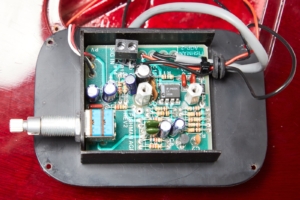

The single master tone control has an advantage, and that’s that it can be used on either pickup, and perhaps most importantly, it can be used when both pickups are on, which leads me to the most interesting part of this guitar.
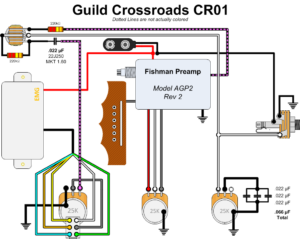
There’s a lot going on in the wiring of this guitar which you might expect given the acoustic/electric nature of the instrument, but it’s even more complicated that that because of the 2-in-1 EMG 89 pickup. Hell, it’s even more complicated than that!
Check out all those wires coming out of the EMG cable on the bottom left of the drawing. Yikes! That’s because the EMG 89 is actually two pickups in one. Next, look at the tone control on the bottom right where there are three ceramic disc capacitors wired in parallel. Why? I’m nowhere near an Electrical Enginer (EE) but my guess is that the math dictates that 66μF is the right solution and the easiest and cheapest way to accomplish that was to use three of the most common capacitors found in Guild’s supply.
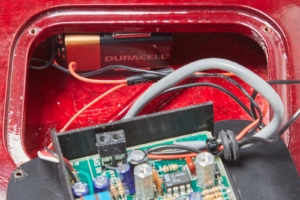
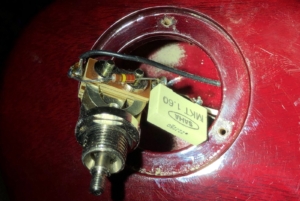
Hardware
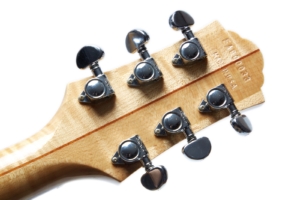
They’re Grover Rotomatics.
Well now I’ve got some space to fill, so I suppose I could tell you how I really like these tuners, but if you’ve read any of my reviews then you already know that. I could tell you that I like the old Schallers better but that’s not really relevant. I could expand on my earlier rant about misuse of the term luthier, but I doubt anyone cares.
Screw it — let’s talk knobs.
The knobs are metal domed cylinders with knurling similar to what you might find on a Fender Telecaster. The knurling on the neck volume knob is a bit more pronounced than on the other two, my guess being because this is the push/pull control for the neck pickup so you can get some extra purchase when pulling on it. All three knobs are set-screw knobs which is a bit odd since the pots are all split-shaft and set-screw knobs are designed for solid-shaft pots. I like the knobs and I especially like the way they play homage to the original Telecaster control layout while also keeping the beautiful maple top clean and elegant. Well, as elegant as it can be with a big ol’ white EMG screwed into it.
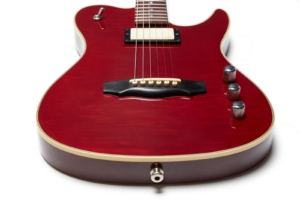
Aside from the bridge being what appears to be a beautiful piece of ebony, there’s really not a lot left to talk about hardware-wise that we haven’t already covered in the Electronics section.
Sound
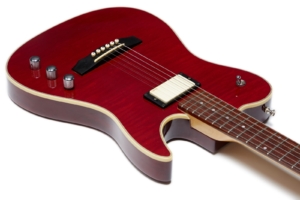
ODS10 – PB Strings
Open E
With phosphor bronze strings the guitar was utterly uninspiring on the EMG pickup but sounded great with the piezo. This is even more obvious when using the middle position since the piezo just overwhelms the EMG. With the EMG in single coil mode, that pickups is completely lost in the mix. I then removed the phosphor bronze strings and put on a set of Ernie Ball Regular Slinky strings and the EMG pickup came alive.
ODS100 Clean
Open Chords #1
Open Chords #2
7th Chords
D-Shape
Miscellany
The guitar has five main pickup selection choices. They are:
- Neck only (humbucker)
- Neck only (single coil)
- Neck (humbucker) + Piezo [mix]
- Neck (single coil) + Piezo [mix]
- Piezo only
As usual, for these recordings I used my normal Axe-FX III through the QSC K12 speaker recorded direct into my Mac Pro using Audacity. I recorded using the ODS100 Clean patch, but for this guitar I didn’t record using the JCM-800 because I just couldn’t imagine myself using this guitar for such a thing. For each recording I cycle through the neck pickup, both pickups, and finally the bridge pickup. All knobs on the guitar are on 10 at all times.
The EMG pickup really kind of left me cold. My favorite by far was the middle position with the EMG in single coil mode mixed with the piezo pickup. I found myself very much wishing that the neck pickup had more character, though.
Playability
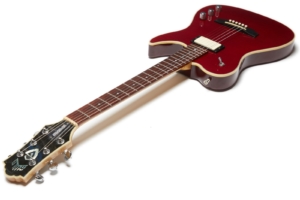
This guitar plays great, but it is a bit confounding to me because of how the wiring is laid out. I mean, on the surface it makes perfect sense because when using the pickup selector the ‘up’ position is the neck pickup and the ‘down’ position is the bridge, but on this guitar you’d likely play an acoustic bit (down) and then flip over to the EMG (up) for a lead. Of course that would only be an issue for the first few rehearsals until muscle memory took over, but I thought I would point out that I found the arrangement kind of non-intuitive from a sound perspective.
Balance-wise, the guitar plays great, likely due to the counter-weights in the body offsetting the weight of the neck. The guitar feels a little heavy at almost eight pounds, but I played a friend’s bigsby-equipped tele in the ’80s that had to weigh 9-10 pounds, so that somehow makes me feel better about this eight pound hollow guitar even though they’re nothing alike.
Conclusion
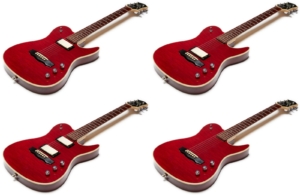
That brings me to my final thoughts which are… complicated. On the one hand, this is a very cool instrument that solves a couple of very common problems. In my opinion, this guitar shines in two ways: First, it plays like an electric guitar while putting out an authentic acoustic guitar sound at volume. For home playing, that’s not such a big deal, but on stage where an acoustic may become a feedback machine, this guitar delivers in a pretty satisfying way. Second, the blending of the EMG and Piezo pickups allows for some really nice tones that I dare say may be unique to this guitar.
I’d say where this guitar loses some of its luster for me is the fact that a) the EMG pickup is in the neck position and b) the fact that the pickup is an EMG. While I have nothing against EMGs, I don’t think the pickup does this guitar any justice, and I think they would have really been onto something if they put one of those wonderful Guild HB1 pickups in there instead. Or two.
It may well be that putting a bridge pickup close to the acoustic bridge was not possible due to how it would impact the top bracing, which honestly makes a lot of sense when I think about it, and I’ll be the first to admit that I may be trying to make the guitar into something it was not intended to be. Still, as Krysh over on the LetsTalkGuild forum will no doubt agree, an HB1 would really make this guitar sing.
I like this guitar but I don’t see it ever being my #1 because it’s just not designed for the styles of music I enjoy most. If you need to transition from an acoustic sound to electric with minimal fuss, this guitar can certainly accommodate you, and I think this guitar would be pretty slick in a coffee shop with a looper, but I’ve spent too much of my life ignoring the neck pickup to be excited about a guitar with no bridge pickup. I could easily argue that this guitar wasn’t designed for me, and that it was designed for working pros who need what it offers, and if that’s you, then this fascinating guitar would likely be a slam dunk. You know, if you can find one.
Donate: PayPal Crypto:
ETH: 0x0AC57f8e0A49dc06Ed4f7926d169342ec4FCd461
Doge: DFWpLqMr6QF67t4wRzvTtNd8UDwjGTQBGs

